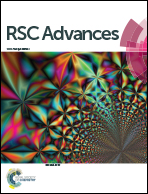Tailoring mechanical properties and electrical conductivity of flexible niobium carbide nanocomposite thin films
Abstract
Flexible NbC nanocomposite thin films with carbon content ranging from 0 to 99 at.% were deposited at room temperature on Si (100) and polystyrene substrates by non-reactive magnetron sputtering from pure Nb and C targets without applying bias voltage to the substrates. HRTEM images reveal that the films exhibit a nanocomposite structure consisting of NbC nanocrystals (2 to 15 nm in size) embedded in an amorphous carbon matrix. By simply adjusting the Nb flux in the plasma, we can monitor the nanocrystal size and the percent of free-carbon phase in the films, which in turn allows for the tailoring of both mechanical properties and electrical conductivity of the films. It was found that the films composed of ∼8–10% free-carbon exhibited a relatively high hardness and elastic recovery, around 23 GPa and 85%, respectively, and an electrical conductivity of 2.2 × 106 S m−1 at 22 °C. This study indicates the potential of this non-reactive sputtering approach in depositing hard, elastic and electrically conductive nanocomposite films at low temperatures, which is especially useful for preparation of films on temperature sensitive polymers or plastic substrates for nano- and micro- electronics applications.


 Please wait while we load your content...
Please wait while we load your content...